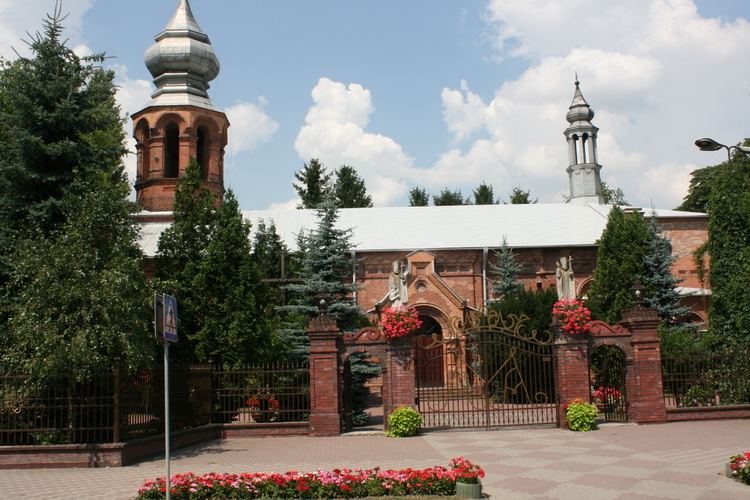Elevation 200 m (700 ft) Postal code 22-500 Population 18,212 (2016) Local time Wednesday 10:39 PM | Time zone CET (UTC+1) Area 33.03 km² | |
 | ||
Weather 3°C, Wind W at 13 km/h, 69% Humidity | ||
Hrubieszów [xruˈbjɛʂuf] (Ukrainian: Грубешів Hrubeshiv, Yiddish: הרויעשאוו) is a town in southeastern Poland, with a population of 18,617 (2006). It is the capital of Hrubieszów County. Since 1999 Hrubieszów has been part of Lublin Voivodeship (Polish: województwo lubelskie). Earlier, 1975–98, it had been part of Zamość Province (województwo zamojskie).
Contents
Map of Hrubieszow, Poland
History
The origins of the town go back to the early Middle Ages, when a Ruthenian defensive gord existed on the Huczwa river island. It was probably part of the so-called “Cherven Towns”, and was first mentioned in 1254, as a hunting settlement located among forests.
In 1366, Red Ruthenia, of which Hrubieszów, then called Rubieszow, was a part, was annexed by the Kingdom of Poland. Some time in the late 14th century, a wooden castle was built here, as a residence of a local starosta. Probably in 1400 Rubieszow received a town charter from Poland's King Władysław Jagiełło, who visited it in 1411, 1413 and 1430. A castle and church were later added. Kazimierz Jagiellończyk built a road from Lublin to Lwow/Lviv passing by Rubieszow. The town was destroyed several times by Crimean Tatars, who raided this area in the 15th, 16th and 17th centuries, and by the Cossacks.
After the first partition of Poland in the late 18th century Hrubieszów was annexed by the Habsburg Empire. In 1800, Stanisław Staszic founded the Hrubieszów Agricultural Society, the first cooperative organization in Europe, which existed until 1945. The name of the town was changed in 1802 from Rubieszow to Hrubieszów. In 1815, it became part of Russian-controlled Congress Poland, within the Lublin Governorate. In 1909, its population was 15,000. In 1916, it became part of the Second Polish Republic.
During World War II, the region witnessed the Zamość Uprising. Many inhabitants, including the 7,000 residents of the town's Jewish ghetto, perished in the holocaust. The city is also notable for being the site in May 1946 of the largest joint action by the partisans of the Polish anti-communist Freedom and Independence movement and those of the Ukrainian Insurgent Army.
After World War II, what remained of the town's Ukrainian population was expelled to the Soviet Union.
Jewish Community
The Jewish population numbered 709 in 1765, 3,276 in 1856, 5,352 (out of 10,636) in 1897, and 11,750 in 1939.
The German army entered the city on 15 September 1939, and immediately organized a series of pogroms. Ten days later the Germans withdrew and the Soviet army occupied the town, but after a fortnight returned it to the Germans, in accordance with a new Soviet-German agreement. Over 2,000 Jews, having experienced the Nazi terror, left with the withdrawing Soviet army. On 2 December 1939, 1,000 Jews from Hrubieszów and 1,100 from Chełm were led on a death march to the Bug River, where 1,500 died. In early 1940, about 6,000 Jews, including refugees, were confined to a ghetto.
In June 1942, around 3,000 Jews from the ghetto were sent to the Sobibor extermination camp where they were all killed. The second deportation from Hrubieszów took place on 28 October 1942, when 2,500 Jews were deported to Sobibor and killed. Around 400 who resisted were executed at the Jewish cemetery and the last 160 Jews were sent to a forced labor camp in Budzyń.
Jewish Resistance
In the summer of 1941, Julek (Joel/Jakób) Brandt, a leader of the Zionist youth movement Betar from Chorzów who was a relative of the chairman of the Hrubieszów Judenrat (Jewish Council) Samuel Brandt, arranged for several hundred members of the Betar youth movement in the Warsaw Ghetto to work on local farms and estates, including one in Dłużniów and Werbkowice. Before the war, the estate in Dłużniów had belonged to Maks Glazermann, a Jewish engineer from Lwów who was left to run the property. Among those sent to Dłużniów was a young woman from Warsaw named Hanka Tauber. Her account of what went on there was recorded in the ghetto diary of Abraham Lewin.
Most of the Betar youth were killed in the spring of 1942 and in subsequent months together with the local Jewish population. A small number, however, managed to return to the ghetto and later took part in the Warsaw Ghetto uprising. Julek Brandt escaped from a transport heading for the Sobibor extermination camp. He was denounced by local peasants who tuned him over to the Gestapo in Hrubieszów. There he was put to work by Gestapo Obersturmbannführer Ebner, who named him chief of a small work camp on Jatkowa Street. At the end of 1942 or the beginning of 1943, Ebner killed him.
Notable People
Notable residents of Hrubieszów have included:
Others with ancestry from the city include:
Monuments
Hrubieszów boasts a number of monuments:
